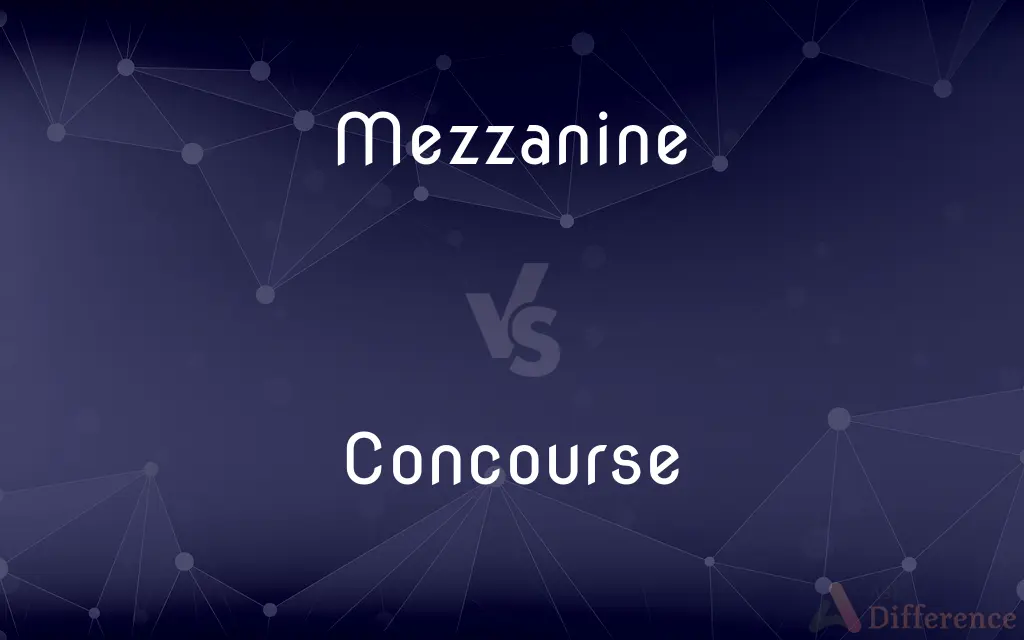Mezzanine vs. Concourse — What's the Difference?
Edited by Tayyaba Rehman — By Fiza Rafique — Updated on March 19, 2024
Mezzanine is an intermediate floor between main floors of a building, partially open to the double-height ceiling area below. Concourse is large open space within a public building, such as airport or train station, where people can gather, walk, or wait.

Difference Between Mezzanine and Concourse
Table of Contents
ADVERTISEMENT
Key Differences
A mezzanine typically serves as an additional floor level situated between the main floors of a structure, providing extra space for seating, offices, or lounge areas without extending the total height of the building. In contrast, a concourse is designed as a spacious hall or area within public buildings or transportation hubs, facilitating movement, access to facilities, and serving as a meeting or waiting area.
Mezzanines are often found in theaters, hotels, and commercial buildings, adding value by maximizing the use of vertical space, offering an overhead view of the area below, and accommodating various functions such as additional seating or retail spaces. Concourses, on the other hand, are integral to airports, train stations, and sports arenas, designed to handle large crowds, provide access to different areas like gates or platforms, and house amenities like shops and restaurants.
While mezzanines contribute to the aesthetic and functional complexity of a building's interior by creating a layered space, concourses prioritize efficient flow and circulation of people, often featuring wide walkways, seating areas, and informational displays to assist navigation and provide comfort.
The architectural design of a mezzanine focuses on integrating it seamlessly with the existing structure, ensuring it complements the building's aesthetics while adding functional space. Conversely, concourses are designed with a focus on scale, capacity, and accessibility, ensuring they can accommodate peak traffic and provide a range of services and amenities.
In essence, mezzanines enhance the utility and visual appeal of a building's interior by adding an extra level within a larger volume, while concourses are built to serve as expansive, multifunctional spaces that facilitate movement, gatherings, and access to various facilities within public and transportation-related buildings.
ADVERTISEMENT
Comparison Chart
Definition
An intermediate floor level between main floors of a building, often partially open.
A large open area within public buildings, designed for movement and gatherings.
Primary Function
Adds additional space for various uses without increasing building height.
Facilitates the flow of people, access to facilities, and provides waiting areas.
Common Locations
Theaters, commercial buildings, galleries.
Airports, train stations, sports arenas.
Design Focus
Integration with building aesthetics, maximizing vertical space.
Handling crowds, efficiency, accessibility, and provision of amenities.
Utility
Enhances building utility by offering extra space for diverse functions.
Serves as a hub for navigation, waiting, and accessing services.
Compare with Definitions
Mezzanine
Intermediate floor level.
The mezzanine in the library provided additional reading spaces overlooking the main floor.
Concourse
Large open space in public buildings.
The airport's main concourse was bustling with travelers.
Mezzanine
Maximizes space usage.
The office building incorporated a mezzanine to add extra workspace.
Concourse
Houses amenities and services.
The concourse offered various shops and restaurants for passengers.
Mezzanine
Aesthetic and functional aspect.
The gallery's mezzanine enhanced the exhibition space aesthetically and functionally.
Concourse
Facilitates movement and gatherings.
Fans congregated in the stadium's concourse before the game.
Mezzanine
Varied applications.
The theater's mezzanine level provided premium seating options for spectators.
Concourse
Key to navigation within large spaces.
Informational kiosks were strategically placed throughout the concourse to assist visitors.
Mezzanine
Partially open to the floor below.
The restaurant's mezzanine offered diners a view of the bustling kitchen.
Concourse
Designed for high traffic.
The train station's concourse was designed to efficiently manage peak-hour crowds.
Mezzanine
A mezzanine (; or in Italian, a mezzanino) is, strictly speaking, an intermediate floor in a building which is partly open to the double-height ceilinged floor below, or which does not extend over the whole floorspace of the building. However, the term is often used loosely for the floor above the ground floor, especially where a very high original ground floor has been split horizontally into two floors.
Concourse
A concourse is a place where pathways or roads meet, such as in a hotel, a convention center, a railway station, an airport terminal, a hall, or other space. The term is not limited to places where there are literally pathways or roadways or train tracks joining.
Mezzanine
A partial story between two main stories of a building.
Concourse
A large open space for the gathering or passage of crowds, as in an airport.
Mezzanine
The lowest balcony in a theater or the first few rows of that balcony.
Concourse
A broad thoroughfare.
Mezzanine
Of or relating to securities granting a claim on interest or assets that is subordinate to that of secured and senior debt but above that of equity.
Concourse
A great crowd; a throng.
Mezzanine
(architectural element)
Concourse
The act of coming, moving, or flowing together.
Mezzanine
An intermediate floor or storey in between the main floors of a building; specifically, one that is directly above the ground floor which does not extend over the whole floorspace of the building, and so resembles a large balcony overlooking the ground floor; an entresol.
On our way to the top floor, we stopped at the mezzanine.
Concourse
A large open space in or in front of a building where people can gather, particularly one joining various paths, as in a rail station or airport terminal, or providing access to and linking the platforms in a railway terminus.
Mezzanine
(by extension) An apartment, room, etc., on such an intermediate floor.
Concourse
Airport terminal.
Mezzanine
The lowest balcony in an auditorium, cinema, theatre, etc.; the dress circle.
Concourse
A large group of people; a crowd.
Mezzanine
(obsolete)
Concourse
The running or flowing together of things; the meeting of things; confluence.
Mezzanine
A floor under the stage, from which contrivances such as traps are worked.
Concourse
An open space, especially in a park, where several roads or paths meet.
Mezzanine
Characteristic of or relating to high-interest loans which have no collateral, and are regarded as intermediate in nature, ranking above equity but below secured loans.
Concourse
(obsolete) concurrence; cooperation
Mezzanine
(engineering) Fulfilling an intermediate or secondary function.
To make interconnections easier, we added a mezzanine PCB.
Concourse
A moving, flowing, or running together; confluence.
The good frame of the universe was not the product of chance or fortuitous concourse of particles of matter.
Mezzanine
(transitive) To fit (a building or other place) with a mezzanine floor.
Concourse
An assembly; a gathering formed by a voluntary or spontaneous moving and meeting in one place.
Amidst the concourse were to be seen the noble ladies of Milan, in gay, fantastic cars, shining in silk brocade.
Mezzanine
Same as Entresol.
Concourse
The place or point of meeting or junction of two bodies.
The drop will begin to move toward the concourse of the glasses.
Mezzanine
A flooring laid over a floor to bring it up to some height or level.
Concourse
An open space where several roads or paths meet; esp. an open space in a park where several roads meet.
Mezzanine
A floor under the stage, from which various contrivances, as traps, are worked.
Concourse
Concurrence; coöperation.
The divine providence is wont to afford its concourse to such proceeding.
Mezzanine
The lowest balcony in a theater, or the forward part of the first balcony.
Concourse
A large gathering of people
Mezzanine
First or lowest balcony
Concourse
A wide hallway in a building where people can walk
Mezzanine
Intermediate floor just above the ground floor
Concourse
A coming together of people
Common Curiosities
How does the design of a mezzanine impact a building's interior?
The design of a mezzanine impacts a building's interior by adding visual interest and functional space within the larger volume, enhancing the building's aesthetics and utility.
What is a mezzanine used for in a building?
A mezzanine is used to provide extra floor space for various purposes, such as additional seating, office space, or lounging areas, within the existing structure of a building.
What is the primary purpose of a concourse in transportation hubs?
In transportation hubs, the primary purpose of a concourse is to manage the flow of people, providing access to gates, platforms, and transit options, while also offering amenities and waiting areas.
Can a mezzanine be added to an existing building?
Yes, a mezzanine can be added to an existing building if the structure and ceiling height allow, offering a way to create additional space without extensive renovations.
What are the characteristics of a concourse?
A concourse is characterized by its large open space, designed to handle crowds, facilitate movement, and provide access to facilities and services in public buildings or transportation hubs.
Are concourses only found in transportation settings?
While concourses are commonly associated with transportation settings like airports and train stations, they can also be found in other large public buildings such as sports arenas and convention centers.
How do architects design concourses to handle peak traffic?
Architects design concourses with wide walkways, clear signage, and strategic placement of amenities and services to manage and streamline the flow of people during peak times.
Can a mezzanine be considered a full floor?
No, a mezzanine is not considered a full floor; it is an intermediate level that is usually partially open to the floor below and does not span the entire footprint of the building.
What facilities might be found in a concourse?
Concourses often house a range of facilities, including ticket counters, information desks, retail stores, restaurants, and restrooms, catering to the needs of the public.
What role do concourses play in the passenger experience at airports?
Concourses play a crucial role in the passenger experience at airports by providing a navigable and comfortable environment that facilitates access to flights, services, and amenities.
How is the space on a mezzanine typically accessed?
Mezzanine spaces are typically accessed via stairs or elevators from the main floors of a building, with considerations for safety and accessibility in its design.
Is a mezzanine always open to the area below?
While mezzanines are often designed to be partially open to the area below, the degree of openness can vary based on the specific design and purpose of the mezzanine.
How do building codes affect mezzanine construction?
Building codes affect mezzanine construction by setting requirements for safety, accessibility, and structural integrity, ensuring the mezzanine is safe and compliant with regulations.
Share Your Discovery

Previous Comparison
Autarchy vs. Autocracy
Next Comparison
Burrow vs. FurrowAuthor Spotlight
Written by
Fiza RafiqueFiza Rafique is a skilled content writer at AskDifference.com, where she meticulously refines and enhances written pieces. Drawing from her vast editorial expertise, Fiza ensures clarity, accuracy, and precision in every article. Passionate about language, she continually seeks to elevate the quality of content for readers worldwide.
Edited by
Tayyaba RehmanTayyaba Rehman is a distinguished writer, currently serving as a primary contributor to askdifference.com. As a researcher in semantics and etymology, Tayyaba's passion for the complexity of languages and their distinctions has found a perfect home on the platform. Tayyaba delves into the intricacies of language, distinguishing between commonly confused words and phrases, thereby providing clarity for readers worldwide.
















































